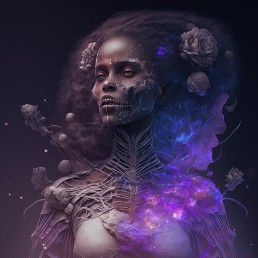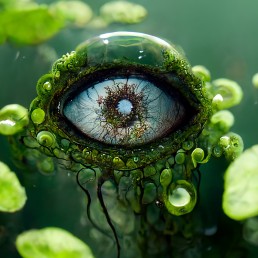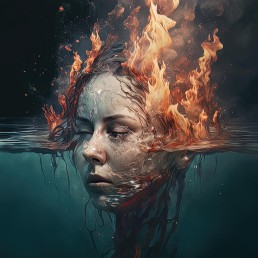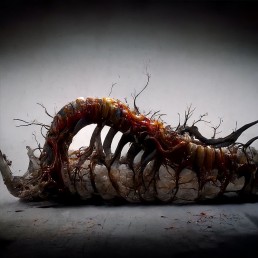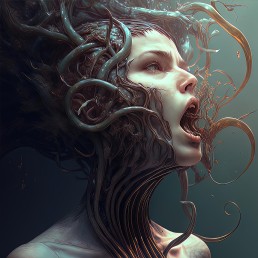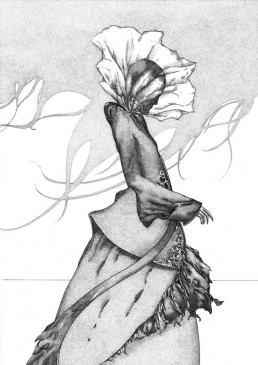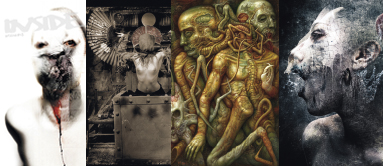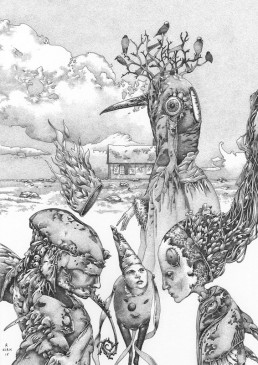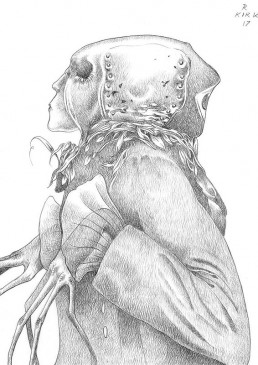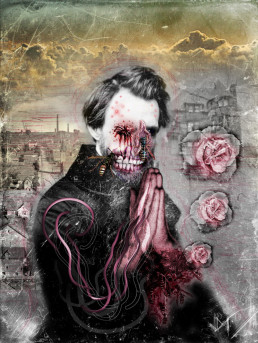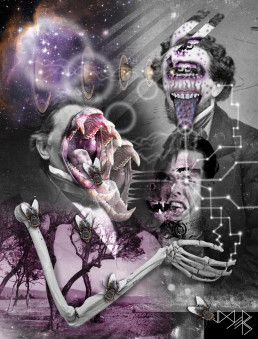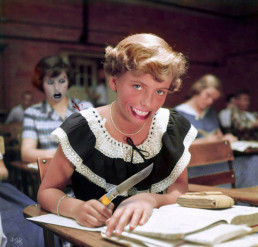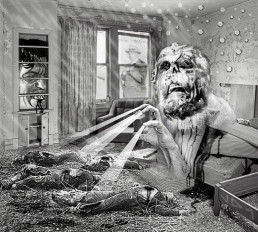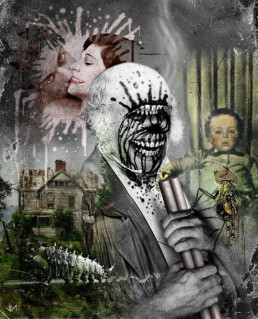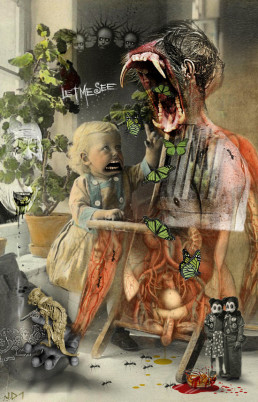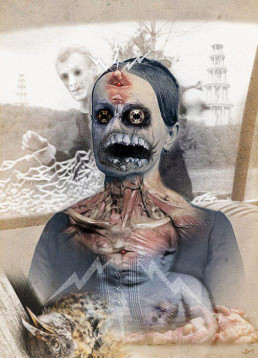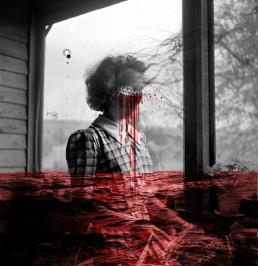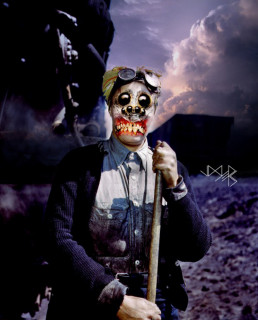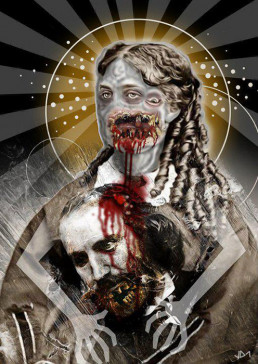Ian "POISONER" Andrews - Rise of the Art-AI
"Generate" instead of "create"- Interview with Ian "Poisoner" Andrews about artificial intelligence in art
Is AI in art evil? For us? Have we let a genie out of the bottle, perfecting itself more and more with every one of the millions of clicks it gets every day? It is difficult to say where this will end, but one can assume that the abilities of an "artificial intelligence", due to its much higher pool of material, will eventually overtake the ability of humans for creativity! In terms of speed, this has already happened.
We talked to someone who should know: American artist Ian "Poisoner" Andrews is a master of the art of engaging with an AI trained to create art. Let's just follow him...
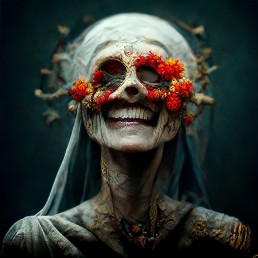
I think many art lovers do not (yet) know what “MidJourney” or “Prompts” are. Please explain how your art is created from a purely technical point of view.
“I’ve been an artist in various forms over the years, including an amateur writer. The Prompts are the language used to essentially tell the AI, in this case Midjourney, what the parameters are for the generation. Prompts are composed of three sections. A main theme, the first section of the prompt sequence; secondary details like setting, atmosphere, type of image (photograph versus oil painting, for example); and the third section of the prompt is all the tweaks, like Finely Detailed, or Photo taken by Sony. These are the embellishments. It’s about understanding how the AI interprets key words and phrases, and it creates weights or priorities to these words based largely on if they appear earlier or later in the prompt.”
You could almost say that the real “art” in this kind of artistic implementation is the definition of an idea and no longer the craftsmanship of this idea. Since AI makes it possible to create any motif in any imaginable style: How concrete is your idea before you start? Or do you also work with the possibility of how the AI deals with your idea?
“I almost look at myself and my relationship to the AI as being a director working with an actor. The AI is the artist, but I am the one telling the story through the prompt. I have a specific style that I lean towards, mainly fantasy type art, but the idea isn’t always completely formed. I may start with a prompt that says “Female Assassin in tactical gear” and then see what comes out the other side. If there are other elements that come to mind during this process, I will copy the prompt and add until I land on something that I like. I do think I have learned through experience how to get the AI to produce a certain result in terms of style, but there are still things that happen for unknown reasons. I was trying to generate an image of a dark elf laying on a bed, and it was giving me just a normal image of a normal woman laying her head on a pillow”
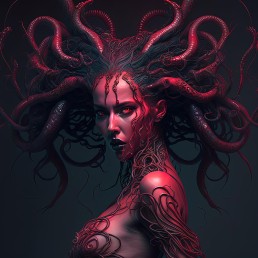
You can find it frightening or fascinating: How do you see AI’s performance in this process? Is it a purely technical matter of computing power and programming or are we entering areas where we admire the result of the machine even though we can no longer understand exactly how it came to this result (called a “black box” in technical language)? The disturbing mystery of an artificial intelligence….
“I can see both sides, but I favor the more optimistic view. There are some phrases I use in my prompts that I have no clue what actual affect it has on the overall image. This comes from the early days of copying other people’s prompts in the event that had a good looking generation. But as time has gone on and AI has improved so much in such a short time, less words will be needed to generate even more amazing results. Even now that Midjourney has entered into its fourth version, with a fifth just a few short months away, it’s already creating results far superior to even the most accomplished artists. But words will still be needed, and people who understand how the AI communicates will always produce better results than those who don’t. I see it all the time on DeviantArt, my online art community. There is plenty of AI garbage being churned out at an impressive speed. I always try to generate quality over quantity.”
As long as “Ai art” is labeled as such, the viewer can decide for himself whether he wants to look only at the idea or at the idea AND the craftsmanship of the artist. If these markings are missing, it becomes difficult in my eyes. Isn’t that a kind of fraud?
“I have been in this conversation many times. I understand why traditional artists are annoyed or even pissed that it is now easier for a layperson to sit down in front of their computer, type a few words, and end up with an amazing piece of art. You’ll noticed I’ve used the term ‘generate’ instead of ‘create’. I don’t view myself as the creator of these works. I add my edits and special touches through Photoshop and various other programs, but by and large, I didn’t create the piece. And I feel for the artists who have had their work be the foundation for training the AI. I won’t go as far to say that it is a copyright issue. If you think about it, all art is derivative. We all get inspiration from other people, and we tend to adopt what we like into our own work. Some of my earlier traditional art when I was younger was heavily influenced by H.R. Giger, although I have no where near the talent he had. So in that sense, the AI never copies an artist, it merely emulates and produces an unique piece in the style of said artist. I personally do not reference any artists in my prompt because it does feel like cheating, but I know a lot of people who don’t have such reservations.”
Finally, a look into the future: this way of creating art (and in my opinion it is!) is very new and its development is certainly not yet at its end. Where do you see future dangers, what will revolutionize art and our view of it?
“Not to sound cliché but the cat is out of the bag when it comes to AI art. There is no putting it back. On the one hand, this has made the act of creation itself so much more accessible to so many people who may not have had the same creative outlet. People with disabilities are able to express themselves in newer ways. And it’s only going to continue to get better over time. Art will be more accessible to the average person, and great artists will still be in demand because AI is far from perfect. As for the future, I know that deepfakes are a real issue in many cases. Pornography, love it or hate it, will be much easier to create. Many working traditional artists will need to adapt to survive. But like all advancements in technology, the industry will adjust and change. New opportunities will present themselves. Since I have been generating AI art, I have created an album cover for an established music group, I’ve been commissioned to create works of art using photographs, I’ve been commissioned to help with a board game. And I was asked to be a part of your publication. None of these things would have happened had it not been for my involvement in AI art generation. I think this shifts the meaning of ‘art’ to something that was once only attainable by the few, to something that is achievable by the many.”
Ian “Poisoner” Andrews Website: Deviant Art
AI recourses for art:
MidJourney
Dall-E 2
Stable Diffusion
Or if you want to start right away: https://huggingface.co/spaces/stabilityai/stable-diffusion
Thanks for the interview. If someone would ask the questioner for his opinion… In my mind, looking at the pure creative output of high quality art, AI is an asset to art. Many people who have great artistic visions and ideas now have a tool to implement them. What otherwise would not have been possible due to a lack of craftsmanship. The more people on this planet who create art, the better off we are. However, if at some point the Chinese (or whoever from our political alpha plague) hacks the internet and destroys it, then AI is dead. And we will have forgotten the craft of painting pictures….
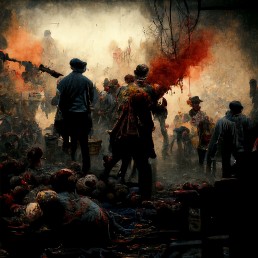
Richard A. Kirk - STRANGER IN A STRANGE MIND: Black and White madness
Gallery and gonzo interview from the fever dreams of a drugless mind
RICHARD A. KIRK IS PUBLISHED IN INSIDE artzine #18 (PREVIEW/BUY)
+++ Chris Mars (USA), Seth Siro Anton (GRE), John Santerinerros (USA), Absumaniac (Poland)
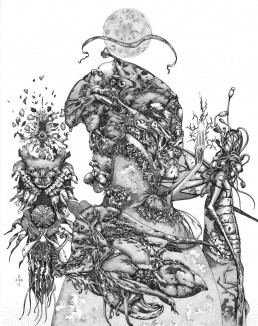

“There is no excellent beauty that hath not some strangeness in the proportion” Sir Frances Bacon, Of Beauty, Essays” 1625
When, finally, I felt strong enough to open my tired eyes completely I realized I wasn’t alone. Not very far away from me, there was an inconspicuous guy in white clothes sitting huddled in the corner, drawing on the wall with a black pen. A black-and-white flood of details arose behind him, like the arms of a naked, dancing octopus. All over the windowless walls, the inaccessible ceiling, the pristine-white PVC floor, up my legs, and out into the crowded, dysfunctional universe of a world without brains. And the things that trickled onto my tense retinas really frightened me. ME! A human-looking bird skull which was entwined with sly, plant-like vines. Swollen flowers, their delicate heads bent into the urinary puddle of daze. Thin skulls, filled with empty eyes. Mouldy mushrooms on seething bodies. Dumb figures in poisonous flower meadows. A woman like weaved of chlorophyll. Spiky insect arms, spindly child legs, torn skin, proliferating, sprawling, weird. And all that in such an obsessive, nightmarish wealth of detail that you had to gasp heavily.


“If you want me to help you, you have to talk to me.” His voice made me wince like a pig at the
butcher’s. I heaved my skull but couldn’t see very much because of all that drool and snot. All I could do was hissing, “… call my lawyer then, asshole!” His pen continued scratching on the wall while he talked to me, “Nobody is here without a reason…” His voice sounded polite and bored, but between his words I could perceive something powerful, something freaky. Something authoritative. I could feel the taste of burning styrofoam trickle into my thoughts: “Who the fuck are you?”
„I am Richard Kirk, a 59-year-old artist – illustrator born in Hull, England in 1962. I grew up in a small industrial city in Ontario, Canada. I’m a draughtsman by nature and the vast majority of my artistic production is done in ink. I also work in silverpoint, a technique with its own special challenges. My choice of technique and subject matter compliment each other. The images come from my imagination, and I represent them in naturalistically, drawing much inspiration from form found in nature. My art explores natural processes. This interest is the focus of my work that lies beneath the narrative: decay, transformation, growth, evolution, and dissolution. My work is frequently described as organic. I am the owner of Pekoe the wonder-dog.“
I stared on the floor in front of me, my balls dug into the ice field. Directly from under my fastened feet, a
walking beetle wriggled itself out which had strange mush-rooms on its head
growing into its mouth. The floor was completely full with his drawings. They seemed to creep towards me and invade through my soles into my skin. It was itching terribly. I wondered whether I should ask him. Beg him. To unfasten me. Or at least scratching me. But then I preferred him staying in his corner. “Eh mate, you’re
frightening me. I really don’t want to know where do you get your ideas…”
His voice sounded as comfy as HAL9000 now: „Nature provides me with a lot of inspiration, as does literature, but it helps to be open to many things. Ultimately, when I sit down to draw I’m not that conscious of external inspiration… “
READ THE COMPLETE STORY IN INSIDE artzine #18 (PREVIEW/BUY)
PRINTS: Big Cartel
Joseph D. Myers (USA) - DEEP IN A HAPPY MIND LURKS RUIN: Bizarre collages from hell
Gallery and interview with the master of the visual abyss.
JOSEPH D. MYERS PUBLISHED IN INSIDE artzine #17 (PREVIEW/BUY)
+++ Matt Lombard (USA), Seth Siro Anton (GRE), Marcelo Vasco (BRA), Yukaman (Japan) +++


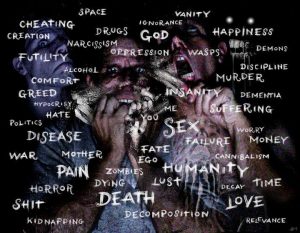



INTERVIEW with Joseph D. Myers (1974-2014)
artscum.org: First, I have to admit, that I have never seen such powerful collages for a long time. They are confusing, disturbing but nevertheless absolutely intriguing in the same time. GREAT JOB! You named your own blog „The Terrible Art of Joseph Donald Myers“. That‘s pretty good description of this wonderful gloomy gallery. Think, „terrible“ is a negative term for most of the people. Can you describe your art in your own words? What is this „terrible“ thing in your art?
JOSEPH:Thanks for the kind words! I think I settled on “terrible” because it describes, both literally and ironically, what my art is about and what I think others may think of it. My work has always been very strange and scary, and I have always wanted people to react strongly, to get some sort of emotional response. I remember back in my high school days a woman (an English teacher, I think) was watching me hang some of my crazy drawings and she looked at me and frowned, not saying anything. After a bit she asked: “What are those supposed to mean?” I said, “I don’t know!” and she walked away. I want my work to be like a beautiful car accident… something you can’t take your eyes away from even if your brain is telling you “Stop looking at this!” I think that’s terrible in the best sense of the word.
artscum.org: The omnipresent deformation steps to a new dimension of ugliness. Do you think ugliness touched the people more than beauty? Think we can imagine, what do think about ugliness so what is your definition of „Beauty“?!
JOSEPH: I think there is so much inherent beauty in what is normally considered “repulsive”, like the grin of a decayed corpse. These “accidental” results of decomposition and nature and humanity – all of this is so deeply fascinating to me. I find beauty in the skeletal remains of a dog, an abandoned home, a stormy sky, a stern portrait of a mother from the 19th century, an image of space captured by the Hubble telescope… the list goes on and on and on. There is so much beauty in darkness. So many details overlooked because of fear.


artscum.org: I‘m curious about your inspirations. Are there any historical examples like the collage dada heros or modern artists like Winston Smith/Dead Kennedys? Any current favorite (collage)artists we should know? What is the fascination of the collage method?!
JOSEPH: As far as my artistic inspirations are concerned, they are many and varied: Salvador Dali, Francis Bacon, Joel Peter Witkin, Al Columbia, Chris Ware, Stanley Kubrick, Stephen King, Robert Crumb, H.R. Giger, Robt. Williams, H.P. Lovecraft, Berni Wrightson, the list goes on and on. So many amazing visions from these wonderful minds. I have learned so much from so many.
I think the digital collage method grew out of me out of necessity, because I was spending so many hours working with Photoshop because of my career. Up until this recent series of digital works my art was created with pens and pencils and pastels, but when I discovered the complexity and depth of the Adobe software, especially Photoshop, my creative world was changed forever. There’s a magical world of creative power contained in what many consider to be a fairly benign yet powerful piece of software. It has allowed me to combine all of the things I find interesting, layer by layer, until the resulting image is born. I always listen to music when I make these things, so I’m tapping into a very deep place, and the art blossoms from these improvisational experiments. It’s very close to what I would consider genuine magic. Because of the ability to find images of literally anything you can imagine or that has existed within seconds (thanks to Google and such), I am able to create these collages as if I were a musician, or a chef… or Dr. Frankenstien. Gathering disparate ingredients and putting them together to create a completely original image. That’s what keeps me interested and amazed. The benign and mundane and feared parts of our world, meeting in a unique way.
artscum.org: Most of your work looks like nightmare visions of a madman. Do think the mind of man is a fragile thing? What must happened to lose control about reality?
JOSEPH: It’s funny, because I’m a pretty “normal”, very happy person. I am a father of three wonderful boys and a husband to an amazing wife, and I grew up with very few worries. But I have also confronted many different demons over the years that have contributed to my macabre artistic tendencies. So I am a bit of a contradiction, I suppose. Which is fine. That adds to the whole mysterious nature of my artwork. J No one really knows what’s going on in my mind except for me, and that’s probably a good thing. But I am so full of love and happiness, many people are quite shocked to see what pours from my imagination. So, yes, I think the mind of man is a very fragile thing… but a fertile ground as well. I am lucky that I have the ability to do something “productive” with my nightmares. Because I think a lot of people, if they were honest, would admit to thinking about some crazy shit from time to time. But instead of tucking those thoughts away, I embrace them and celebrate them. I become friends with them. Much better to be friends with darkness and fear and horror than enemies.
artscum.org: Do think that everything that seems to be possible use as an object in art? Or is there are anything that be taboo, even in art?!
JOSEPH: I think the “taboo” has to play a part in what I’m doing in order to make the viewer question their own sensibilities about what is “gross” or “perverse” or “forbidden”. I try to avoid gratuitous violence or pornography, but sometimes the animal tendencies that lie within the heart of man have no choice but to show themselves, especially in my art. One thing that I explore and embrace in my work is post-mortem photography from the 19th century. There are so many hauntingly beautiful images of loved ones that died too young before their time… because the mortality rate was so high back then, and photography was such a new technology, people were embracing it as a means to keep the memory of the dead alive forever. So people would sometimes pose the departed in a natural setting, or simply take a picture of them during a funeral viewing. Anything to hold onto the memory through photography. That’s so fascinating to me… and these slices of time/space are captured like magic, the subjects never knowing that someday, some guy with a computer would be staring into those eyes to find beauty and inspiration.


artscum.org: I‘m always curious about the man behind the art. Often the audience compare the artist with his art. So are you an incurable lunatic with bad dreams or an intellectual visionary who can see things we can not see? What do you tell your new girlfriend, parents, neighbors about your art. Or do give a damn about the reaction/opinion of your audience?
JOSEPH: I think I’m someone who’s not afraid to find beauty in horror, order in chaos, and translate that into something interesting and powerful for the viewer to appreciate. Maybe they’ll look at the world a little differently after studying my work, who knows… I just don’t want people to dismiss what I do as the artistic equivalent of a raving lunatic. The world is a scary, scary place. I’m just holding up a funhouse mirror for everyone to see a little bit more.
artscum.org: Mankind more and more develops into a heap of selfish, daft self-destructors, both as for globalization and respect for one another. What is left of the beauty of the cosmic creation? Of the creative spark for perfection? Does Mankind still have a chance, or would it be better to flush the whole shit down the toilet of the evolutionary failure to give the future protozoa a shot for life?
JOSEPH: Best question ever! The state of modern humanity frightens me deeply. I think the human race is pushing itself to extremes, both positive and negative. This balancing act, although important, is very nerve-wracking. I fear that there is a very fine line between control and chaos, civility and barbarism. But I also think that there is so much love, so much good in the world. It’s disturbing how ignorant and shallow-minded many people have become, and I truly hope that people will begin to truly understand the power of compromise and love and peace. Maybe this obsession with self-destruction will fade away someday, but it may take an “act of God” to truly correct all of the problems on our wonderful planet. A wildfire to even things out, create a fresh stage for true spiritual rebirth. But until that time, we have to maintain our corners of the universe and try to appreciate the good aspects of life. But we can’t always turn away from the darkness, the horrible, the terrifying. Sometimes we have to face and embrace these things like dear friends.
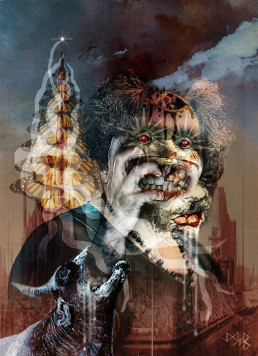

JOSEPH: Jenz, one very important thing that I forgot to mention was my fascination with TEETH! Teeth are a HUGE part of my aesthetic, and I will forever be fascinated by how deeply primal and scary they can be. One of those things we take for granted, but can be so much more than what they are designed for. Sort of like how the female breast has taken on a sexual appeal… I mean, they were designed as very efficient and well-designed food producers/containers when you think about it. Only through human perception have they become sex objects. Just like teeth, although designed to be perfect food cutters and smashers, have become much more interesting to me over the years. So powerful and frightening, and very much a part of our Mammal heritage.
My current body of work, which I began in early 2009, is an almost direct response to the death of my mother. Although the Number One Champion of my artwork, Mrs. Linda Myers did not, however, enjoy my more sinister sensibilities. “Why don’t you do something nice?” she’d ask on a regular basis. “Because I don’t really know how”, I’d reply. As I struggled with the idea that she was no longer physically present, I also realized that I could explore death and dying (and the beauty that surrounds it) to my heart’s content without the worry of disappointing her. Sounds strange, especially since my mom was/is The Most Amazing Mother a son could have asked for and her loss is a void that will never truly be filled. All the same, she taught me how to find silver linings in the strangest of places. The result has been close to 200 unique pieces since April of 2009.
My creative process is relatively complex, albeit one that has become deeply intuitive over the past few years. My essential goal to tap into the deep fears of my childhood as well as the fears I have developed as an adult. It all starts with a scavenger hunt of sorts. I scour the internet for images that involve, but are not limited to: death, dying, old portraits, wars, mouths and teeth, insanity, deformity, landscapes, insects that scare me (especially wasps), aggressive animals, humanity in general… the list could go on and on. I will also photograph parts of my own body or use original nature photography if there’s a certain “something” I’m attempting to capture. Then, like an improvisational chef or musician (or Dr. Frankenstein), I start assembling bits and pieces of the images that have spoken to me using Photoshop. Many times I will create separate illustrations that will fill in certain gaps or add to the overall effect. If there is any need for text in the piece I will hand draw and scan that as well. Sometimes I attempt to incorporate a theme, other times the themes emerge like long-silenced screams from the past. I want to present to the world unique images that are at once familiar and terribly alien; comforting and disturbing; beautiful and terrifying. I want to welcome you into my brightly-lit home on a pleasant Spring morning, then slam the door, turn out the lights and strap you to a chair with eyelids held open forcing you to see what lurks in the dark, mad corners of the universe.
Or something like that.

